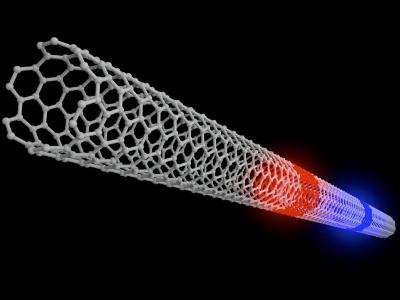Nano-Cnr Modena researchers have discovered a new state of matter in carbon nanotubes

Researchers of the Nanoscience Institute of the National Research Council (Nano-Cnr) have proven that in carbon nanotubes a new quantum state of matter - known as excitonic insulator - takes place spontaneously. That state had only been predicted half a century ago by Nobel prize Walter Kohn, without never being definitely confirmed until now. The study, which was carried out in collaboration with Sissa (International High School of Advanced Studies), Iom-Cnr (Material Workshop Institute) and Ism-Cnr (Matter Structure Institute) of the research national council, was published on Nature Communications.
Carbon nanotubes are cylinders obtained from graphene, a two-dimensional material made of a one-atom thick carbon sheet that, once rolled-up, makes up tubes with a ray of few nanometres (a nanometre is equal to one billionth of a metre) and a length of the diameter of a hair. Until now, the behaviour of an important class of nanotubes able to carry electrical current had been explained by assuming that the electrons of carbon atoms move easily and separately from each other throughout the entire length, i.e. the material acts like a metal. However, Nano-Cnr researchers have proved that when an electron leaves a carbon atom, it does not move freely and links with the hole behind it, creating a composite particle made up of the electron and the hole, known as exciton.
“We have reproduced the collective behaviour of all these excitons by means of sophisticated and extremely reliable numerical simulations based on quantum mechanics”, Massimo Rontani of Nano-Cnr explains, “and checked that electrons are free to move only if enough energy is supplied to dissolve the excitons. This means that the nanotube acts like an insulating material, an excitonic insulator: it is a long time pursued elusive quantum phenomenon.
Nanotubes are an ideal system for nanoelectronics, as they act like tiny lead wires. By proving the existence of the excitonic insulator in carbon nanotubes for the first time, this study will enable a better understanding of the mechanism by which nanotubes act like metal or insulating material. “In this research we have started from the beginning, ignoring the established opinion that the excitonic insulator could not exist in carbon nanotubes”, Daniele Varsano of Nano-Cnr explains. “We have reached reliable conclusions after extremely complex numerical simulations on super computer systems, that were carried out thanks to the centre of excellence MaX, a European infrastructure dedicated to computing research on materials lead by Nano-Cnr. Recent developments on high performance computing have made possible to predict properties of the matter that have not yet been studied, and until a few years ago were considered impossible and confined to textbooks”.
Article published by: Unimore Press Office - ufficiostampa@unimore.it
Categorie: International - english
Articolo pubblicato da: Ufficio Stampa Unimore - ufficiostampa@unimore.it il 27/03/2018

